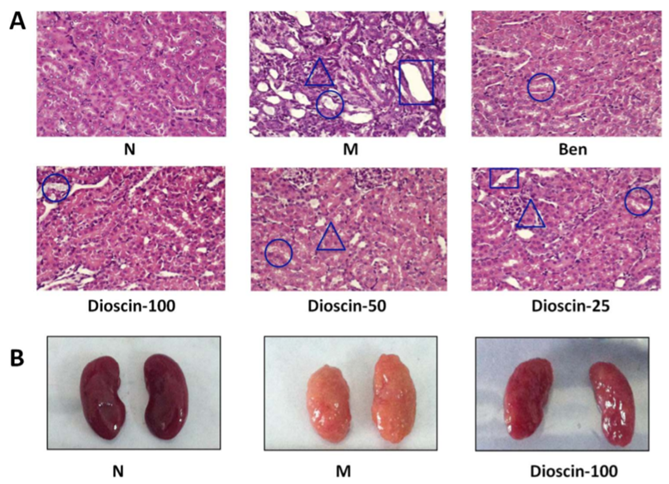Animal Model of Hyperuricemia
Hyperuricaemia is a metabolic disease characterized by high levels of blood uric acid. Uric acid is an end product of purine metabolism and hyperuricaemia is caused by purine metabolic abnormalities. It has been indicated that hyperuricaemia is an important risk factor for gout, cardiovascular disease, hypertension, diabetes, and chronic kidney disease. In recent years, the prevalence of hyperuricemia in the world has gradually increased. However, its specific pathogenesis and targeting drugs still need further study.
Creative Bioarray, with a prestigious team in the industry, focuses on providing customized experiment services to help customers assess the efficacy of compounds and study the associated pathological mechanisms of hyperuricemia.
Hyperuricemia include but not limited to:
- Potassium Oxonate-induced Hyperuricaemia Model
- Yeast Extract and Potassium Oxonate-Induced Hyperuricemia Model
- Fructose and Potassium Oxonate-Induced Hyperuricemia Model
Species available
- Rat
- Mouse
Our capabilities
- We analyze the level of uric acid using Ultra Performance Liquid Chromatography (UPLC).
- We evaluate the effect of test compounds on the histopathology of renel tissue by H&E staining.
Assays available
- Blood collection
- Decection of the level of uric acid
- Biochemical analysis
- Pathological evaluation
With extensive experience in the field of hyperuricemia, we are confident to help you overcome any upcoming challenges. Our experts are fully capable of customizing our protocols and assays to meet your specific needs. With our help, we wish to facilitate your research with high efficiency.
Study examples
 Figure. 1. Effect of Dioscin on the histopathology of renal tissue in hyperuricemia mice . A: Histopathological analysis of renal tissues after induced by using adenine and PO (HE, ×400); B: Phenotype of kidney in hyperuricemia mice; N: Normal rat; M: Adenine and PO induced hyperuricemia mice; Ben: Adenine and PO induced hyperuricemia mice with Probenecid 50 mg/kg/day (p.o.); Dioscin: PO induced hyperuricemia rat with Dioscin in different dosage; Δ: mixed cellular infiltrate in the tubules; О: corpora amylacea; □: tubular ectasia.
Figure. 1. Effect of Dioscin on the histopathology of renal tissue in hyperuricemia mice . A: Histopathological analysis of renal tissues after induced by using adenine and PO (HE, ×400); B: Phenotype of kidney in hyperuricemia mice; N: Normal rat; M: Adenine and PO induced hyperuricemia mice; Ben: Adenine and PO induced hyperuricemia mice with Probenecid 50 mg/kg/day (p.o.); Dioscin: PO induced hyperuricemia rat with Dioscin in different dosage; Δ: mixed cellular infiltrate in the tubules; О: corpora amylacea; □: tubular ectasia.
Quotation and ordering
If you have any special needs or questions regarding our services, please feel free to contact us. We look forward to cooperating with you in the future.
Reference
Zhang Y , Jin L , Liu J , et al. Effect and mechanism of dioscin from Dioscorea spongiosa on uric acid excretion in animal model of hyperuricemia[J]. Journal of Ethnopharmacology, 2017, 214:29.
For research use only. Not for any other purpose.
Disease Models
- Oncology Models
-
Inflammation & Autoimmune Disease Models
- Rheumatoid Arthritis Models
- Glomerulonephritis Models
- Multiple Sclerosis (MS) Models
- Ocular Inflammation Models
- Sjögren's Syndrome Model
- LPS-induced Acute Lung Injury Model
- Peritonitis Models
- Passive Cutaneous Anaphylaxis Model
- Delayed-Type Hypersensitivity (DTH) Models
- Inflammatory Bowel Disease Models
- Systemic Lupus Erythematosus Animal Models
- Oral Mucositis Model
- Asthma Model
- Sepsis Model
- Psoriasis Model
- Atopic Dermatitis (AD) Model
- Scleroderma Model
- Gouty Arthritis Model
- Carrageenan-Induced Air Pouch Synovitis Model
- Carrageenan-Induced Paw Edema Model
- Experimental Autoimmune Myasthenia Gravis (EAMG) Model
- Graft-versus-host Disease (GvHD) Models
-
Cardiovascular Disease Models
- Surgical Models
- Animal Models of Hypertension
- Venous Thrombosis Model
- Atherosclerosis model
- Cardiac Arrhythmia Model
- Hyperlipoidemia Model
- Doxorubicin-induced Heart Failure Model
- Isoproterenol-induced Heart Failure Model
- Arterial Thrombosis Model
- Pulmonary Arterial Hypertension (PAH) Models
- Heart Failure with Preserved Ejection Fraction (HFpEF) Model
-
Neurological Disease Models
- Alzheimer's Disease Modeling and Assays
- Seizure Models
- Parkinson's Disease Models
- Ischemic Stroke Models
- Acute Spinal Cord Injury (ASCI) Model
- Traumatic Brain Injury (TBI) Model
- Hypoxic-Ischemic Encephalopathy (HIE) Model
- Tourette Syndrome (TS) Model
- Amyotrophic Lateral Sclerosis (ALS) Model
- Huntington's Disease (HD) Model
- Intracerebral hemorrhage (ICH) Models
- Schizophrenia Model
- Pain Models
-
Metabolic Disease Models
- Type 1 Diabetes Mellitus Model
- Type 2 Diabetes Mellitus Model
- Animal Model of Hyperuricemia
-
Nonalcoholic Fatty Liver Disease Model
- High-Fat Diet-Induced Nonalcoholic Fatty Liver Disease (NAFLD) Model
- Methionine and Choline Deficient (MCD) Diet-Induced Nonalcoholic Fatty Liver Disease (NAFLD) Model
- Gubra-Amylin NASH (GAN) Diet-Induced Nonalcoholic Fatty Liver Disease (NAFLD) Model
- Streptozotocin (STZ) Induced Nonalcoholic Fatty Liver Disease (NAFLD) Model
- High Fat Diet-Induced Obesity Model
- Diabetic Foot Ulcer (DFU) Model
- Liver Disease Models
- Rare Disease Models
- Respiratory Disease Models
- Digestive Disease Models
-
Urology Disease Models
- Cisplatin-induced Nephrotoxicity Model
- Unilateral Ureteral Obstruction Model
- 5/6 Nephrectomy Model
- Renal Ischemia-Reperfusion Injury (RIRI) Model
- Diabetic Nephropathy (DN) Models
- Passive Heymann Nephritis (PHN) Model
- Adenine-Induced Chronic Kidney Disease (CKD) Model
- Kidney Stone Model
- Doxorubicin-Induced Nephropathy Model
- Orthotopic Kidney Transplantation Model
- Orthopedic Disease Models
- Ocular Disease Models
- Skin Disease Models
- Infectious Disease Models
- Otology Disease Models